
The Mangla Dam is a multipurpose dam located on the Jhelum River in the Mirpur District of Azad Kashmir in Pakistan. It is the seventh largest dam in the world. The dam got its name from the village of Mangla. Major Nasrullah Khan of the Pakistan Army revealed for the first time in 2003, that the project was designed and supervised by Binnie & Partners of London, and it was built by Mangla Dam Contractors, a consortium of 8 U.S. construction firms, sponsored by Guy F. Atkinson Company of South San Francisco.
Panjnad area is located in Punjab, Pakistan. It is an agricultural area near Uchh, Bahawalpur and it is where all the five rivers of Punjab merge. It is a beautiful picnic point and known for its fresh fish. One kilometer south east is Nalka Adda where you can find a good marketplace.At Nalka Adda there is Dada Dadi free medical dispensary supervised by Associate professor paediatric medicine Dr Muhammad Azam Khan Gabol. Panjnad Headworks or Panjnad barrage has three canals namely panjnad canal ; abbassia canal and abbassia link canal. These canals irrigate Bahawalpur and Rahim Yar Khan districts and the northern Sindh area.
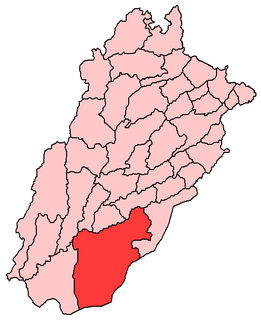
Bahawalpur District is one of the districts of Punjab, Pakistan. Its capital is the city of Bahawalpur. According to the 1998 Census of Pakistan it had a population of 2,433,091, of which 27.01% were urban. Bahawalpur district covers 24,830 km². Approximately two-thirds of the district (16,000 km²) is covered by the Cholistan Desert, which extends into the Thar Desert of India. The district is a major producer of cotton.

Sukkur Barrage is a barrage on the River Indus near the city of Sukkur in the Sindh province of Pakistan. The Barrage was built during the British Raj from 1923 to 1932 and was named Lloyd Barrage. The Sukkur Barrage, is the pride of Pakistan’s Irrigation system as it is the largest single Irrigation network of its kind in the world. It irrigates from Sukkur District in the North, to Mirpurkhas/ Tharparkar and Hyderabad districts in the South of Sindh, almost all parts of the Province except few. It is situated about 300 miles North East of Karachi, 3 miles below the Railway Bridge, or the Sukkur Gorge. The introduction of barrage-controlled irrigation system resulted in more timely water supplies for the existing cultivated areas of Sindh Province of Pakistan.

Vehari also spelled Vihari, is a city about 100 km (62 mi) from the historical city of Multan and is the headquarters of Vehari District in the Punjab province of Pakistan. It is at the Multan Delhi Road constructed by Indian Muslim Emperor Sher Shah Suri. It is at an altitude of 135 m (443 ft).
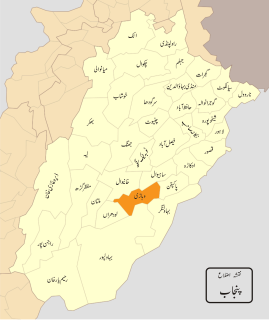
Vehari District, , is a district in the Punjab province of Pakistan. The city of Vehari is the capital of the district.

Burewala, , is a city of Vehari District in Punjab, Pakistan. The city of Burewala is the headquarters of Burewala Tehsil, an administrative subdivision of the district. It is located at 30°10'0N 72°39'0E and has an altitude of 133 metres (439 feet). According to the 1998 census of Pakistan, Burewala had a population of about 150,000 people. As of 2000, it is the 31st biggest city in Pakistan by population. Postal code of Burewala is 61010.

The Swat River is a perennial river in the northern region of Khyber-Pakhtunkhwa Province, Pakistan. The river commences in the Kalam Valley of Swat Kohistan with the confluence of two main tributaries Ushu and Utrar and runs downstream in a narrow gorge up to Baghdheri.

Chashma Barrage is a barrage on the River Indus in Mianwali District of the Punjab province of Pakistan 304 km NW of Lahore and 56 km downstream of Jinnah Barrage. The contract for Chashma Barrage works was awarded on 10 February 1967 to French Consortium Société Dumez and Société Borie and was successfully completed by 25 March 1971. The total cost of Chashma Barrage works was Rs.399 million but power generation started later in 2001. The installed capacity of power Station is 184 MW, from eight Kaplan-type bulb turbine units, each with a 23 MW capacity. The bulb turbines have been installed for the first time in Pakistan. The first unit was commissioned in January 2001, while final commissioning of all units was completed in July 2001. The 8 Kaplan-type turbines and synchronous generator units were made by Fuji, Japan.
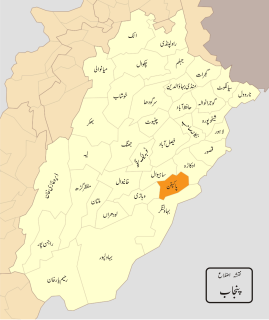
Pakpattan District, , is a district of Punjab province in Pakistan, Pakpattan is the district capital. According to the 1998 census of Pakistan, it had a population of 1,286,680 of which 14% were urban. It has since risen to 1,563,000.
Khanki Headworks is a headworks situated on the River Chenab in Gujranwala District of the Punjab province of Pakistan. It was constructed in 1889 and is considered to be the oldest headworks in Pakistan.
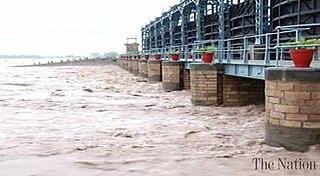
Marala Headworks is a headworks situated on the River Chenab near the city of Sialkot in Punjab province of the Pakistan.

Islam Barrage is a barrage on the River Sutlej in Hasilpur Tehsil of the Punjab province of Pakistan

Sahiwal Division is one of the nine Divisions of Punjab province, Pakistan. In 1998, the population of Sahiwal was 6,271,247. The population rate of growth was 1.92 percent per annum. In 2008, Sahiwal Division was divided into three districts: Sahiwal District, Okara District and Pakpattan District. The city of Sahiwal is the capital of both Sahiwal District and Sahiwal Division.
Rasul Barrage is a barrage on the River Jehlum between Jhelum District and Mandi Bahauddin District of the Punjab province of Pakistan. It is situated 72 km downstream of Mangla Dam.
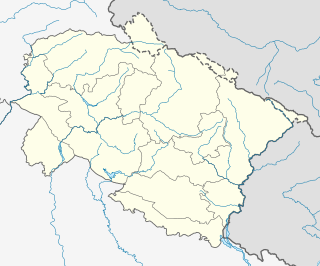
The Bhimgoda Barrage, also referred to as the Bhimgoda Weir or Bhimgoda Head Works, is a barrage on the Ganges River at Har ki Pauri near Haridwar in Haridwar district, Uttarakhand, India. Built as the headworks of the Upper Ganges Canal, an initial barrage was completed by 1854 and replaced twice; the final one completed in 1983. The primary purpose for the barrage is irrigation but it also serves to provide water for hydroelectric power production and control floods. The area behind the barrage is known as the Neel Dhara Bird Sanctuary and is a popular destination for various waterbirds and tourists.

The Tungabhadra Dam also known as Pampa Sagar is constructed across the Tungabhadra River, a tributary of the Krishna River. The dam is in Munirabad, Koppal district of Karnataka. It is a multipurpose dam serving irrigation, electricity generation, flood control, etc. This is a joint project of erstwhile Hyderabad state and erstwhile Madras Presidency when the construction was started; later it became a joint project of Karnataka and Andhra Pradesh after its completion in 1953. The main architect of the dam was Dr Thirumala Iyengar, an engineer from Madras. There is a dispute between Andhra Pradesh,Telangana and Karnataka for the water of Tungabhadra reservoir. The main contractor for the dam was Venkat Reddy Mulamalla, from Konour village, Mahabubnagar, Hyderabad state.

Bunga Hayat is a small town in Pakpattan District, Sahiwal Division, Punjab, Pakistan, having a population of 10,000. It is named after Mian Hayat Maneka, an ancestor of the Maneka Family. Prominent politicians from the area are Mian Khudayar Khan Maneka, elected twice as the MLA before partition. Mian Farrukh Mumtaz maneka (MPA) Mian Khurram Mumtaz Maneka and Mian Asadullah Mumtaz Maneka(Ex.Dist Naib Nazim Pakpattan).Mian Muhammad Yar khan Maneka and Mian Mimshad Ahmed Maneka Their father Mian Mumtaz Maneka was also an influential political leader of the area. Among 28 Union Councils of Tehsil Pakpattan, Bunga Hayat Union Council is UC-03. UC Bunga Hayat Consists of Bunga Hayat, Nanakpur, Asadullah, Arazi Amar Singh, Magan Pur, 5 Marla Scheme & 7 Marla Scheme.

Pakpattan Hydropower Plant is a small hydro, low head project of 4.2 metres, located in the Pakpattan District on the Upper Chenab Canal, in Punjab Province, Pakistan. It is approximately 245 km from the provincial capital of Lahore in the Islamic Republic of Pakistan.
Left Bank Outfall Drain is a drainage canal in Pakistan. Built between 1987 and 1997 using funding from the World Bank, the canal collects saline water, industrial effluents and Indus river basin floodwater from more than two million hectares of land of Shaheed Benazirabad, Sanghar, Mirpurkhas and Badin districts located in Nara river basin into the Arabian Sea.




















